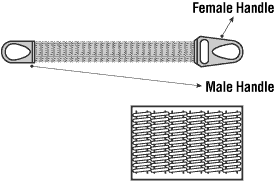Materials Handling - Metal Mesh Slings
On this page
- What are the characteristics of the metal mesh slings?
- When should you use metal mesh slings?
- When should you inspect the sling?
- What should you look for when inspecting a metal-mesh sling?
- What should you do when one or more of the above conditions are identified?
- How should you use metal-mesh slings safely?
- What should you avoid when using metal-mesh slings?
What are the characteristics of the metal mesh slings?
Back to topMetal mesh slings:
- Are made from carbon steel, stainless steel or alloy steel.
- Can be coated or impregnated with elastomers (e.g., PVC, neoprene).
- Those not impregnated with elastomers are temperature resistant (from - 29°C to 288° C).
- Those impregnated with elastomer have narrower temperature work range (-18°C to 93°C).
- Are flexible.
- Are resistant to corrosion (carbon steel and stainless steel slings).
- Do not stretch extensively.
When should you use metal mesh slings?
Back to topWhen the loads are:
- Hot.
- Abrasive.
- Have sharp edges that could damage the other slings.
When should you inspect the sling?
Back to top- Visually check it every day before use.
- Periodically, as recommended by the manufacturer, or at least once a year.
What should you look for when inspecting a metal-mesh sling?
Back to top
- Missing or unreadable identification plate.
- Broken wires in any part of the mesh.
- Broken weld or joints along the sling edge.
- Distortion and reduced flexibility.
- Distortion of chocker fittings (slot longer by more than 10% of initial length).
- Distortion of end fittings that causes the width of eye opening to decrease by more than 10%.
- Reduction in wire diameter of 25% due to abrasion or 15% due to corrosion.
- Reduction of 15% or more of the initial cross-sectional area in any point around the hook opening of the end fitting.
- Cracked, corroded, pitted, bent, twisted or broken end fittings.
- Locked spirals without free articulation (movement).
- Slings with missing or illegible identification marks.
What should you do when one or more of the above conditions are identified?
Back to top- Remove sling from use and discard or repair them.
- Do not try to repair the sling yourself by hammering it. Send the sling to be repaired by the sling manufacturer.
- Use only repaired slings that were proof tested by the sling manufacturer.
- Keep the certificates of the proof test.
How should you use metal-mesh slings safely?
Back to top- Use only slings that have the identification plate on them.
- Know the admissible safe load for the slinging configuration you want to use.
- Make sure that the load is balanced.
- In a chocker hitch, ensure that the female handle chokes on the metal mesh and not on the handle.
- Keep body parts away from the area between the load and the sling.
- Make a trial lift and a trial lower to ensure everything is working in a safe manner.
- Reduce sling stress with slow starts and stops.
- Wipe the dirt after use and store on racks as recommended by the manufacturer.
- Only use slings that are exposed to extreme temperatures as recommended by the manufacturer or qualified person.
What should you avoid when using metal-mesh slings?
Back to top- Do not use metal-mesh slings for loads heavier than the safe load.
- Do not use horizontal angles less than 30 degrees except as recommended by the sling manufacturer or a qualified person.
- Do not use damaged slings.
- Do not drag slings out from underneath a load.
- Do not use a fitting unless it is the correct shape and size to fit properly in the hook or lifting device.
- Do not use metal-mesh slings as bridles on suspended personnel platforms.
- Do not shorten metal-mesh slings with knots or bolts.
- Do not apply coatings that may lessen the sling's rated capacity.
- Do not store the slings in areas where they might be exposed to corrosive agents or subjected to mechanical stress.
- Do not use metal-mesh slings outside the temperature range recommended by the manufacturer.
- Fact sheet last revised: 2019-05-17
